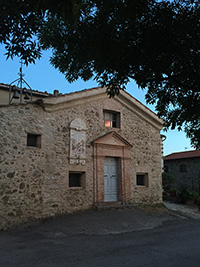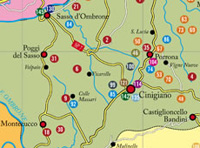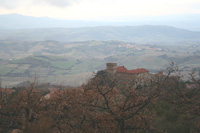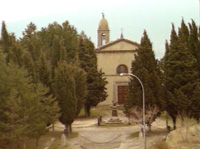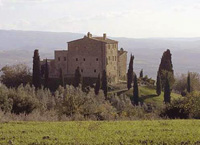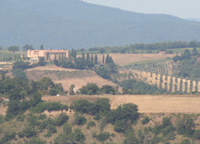Cinigiano |
| Cinigiano is
one of Tuscany's hidden gems. Cinigiano rises on a hill west of the massif of Mount Amiata. It is a quiet village bordering the plains of Maremma. In the main square there is the seat of the Strada del vino (wine trail) and the headquarters of the Pro-Loco (tourist information office) where you can find all the informations necessary to discover the beauty of the Maremma. Cinigiano is shaped like a fortified village and preserves part of the walls and remains of the ancient fortress. The passing of centuries cancelled out most traces of the earliest buildings, but one can still see the symbol of public power of Cinigiano: the Clock Tower. The Tower was reconstructed in the 19th century, hereby reviving the medieval style, which was fashionable at that time. Of special interest are the Church of St. Michael Archangel and the Chiesa della Madonna delle Nevi (Church of the Madonna of the Snow). In the upper part of Cinigiano, at the end of Via del Pretoria, you can find the church that the town has dedicated to its patron saint: St. Michael Archangel. Extremely simple, it is mentioned in documents as far back as the 13th century, but owes its current appearance to reconstruction work carried out near the end of the 1500s and to restoration work carried out in 1976. It has a brick facade with a central portal with a circular eye above it. The interior, a chamber, has a T-shaped layout and contains a few art works of stylistic importance. Of note for its masterly workmanship and the strong religious sentiment it conveys, is the 18th century canvas by Francesco Vanni depicting La Crocifissione con i Dolenti, la Madonna e Santi (The Crucifixion with Mourners, the Madonna and Saints). Also of excellent quality is a painting depicting La Madonna col Bambino in gloria che consegna lo scapolare a san Simone Stock (The Madonna with Child in Glory who Delivers the Scapular to St. Simon Stock), from a 17th century Sienese workshop.[1] Il Cassero (Bridge House) is a fortified construction which is situated in the highest part of the town, in the historic centre.
|
||||
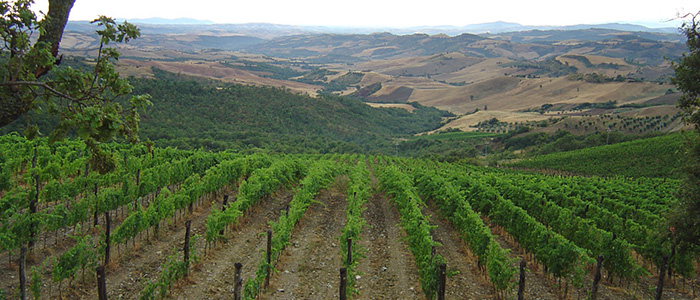 |
||||
Montecucco vineyards on the slopes of the
|
||||
The Montecucco DOC area is nestled between Montalcino, home of the renowned Brunello di Montalcino DOCG, and Scansano, birthplace of the Morellino di Scansano DOCG. Despite having a viticultural heritage dating as far back as the eighth century, this winemaking zone was only awarded its DOC classification in 1998.
|
||||
| The lower part of the the northern Maremma is made up of several quality wine areas. Montecucco is the area South West of the Montalcino plateau. D.O.C. Montecucco area covers a small section of the province Siena and a large part of the Maremma, usually known as Upper Maremma. The Montecucco Wine Trail runs through a vast area situated on the slopes of Mount Amiata, which has its centre at Cinigiano, lying between the Maremma region and Amiata. The seven Comuni which produce the Montecucco DOC wine are, besides Cinigiano: Civitella Paganico, Campagnatico, Castel del Piano, Arcidosso, Seggiano and Roccalbegna. The Montecucco wine trail (La Strada del Vino Montecucco) consists of a main roadway with five turn-offs. It can also be found on the official site of Strada del Vino Montecucco - Montecucco Wine Trail. In Octobre, Tuscany really comes to life, with festivals and celebrations all revolving around one of the region’s most prized assets – wine. In Cinigiano that still maintains an old-fashioned, rural way of life, the Festa dell'Uva or wine harvest festival, takes place every year on the first October weekend.
Calici di Stelle, the wine and food event of the summer |
||||
The better way to taste the local wine is to come to Cinigiano in August during the Calici di Stelle wine event.
Festa dell'uva
|
 |
|||
Century-old olive trees
|
||||
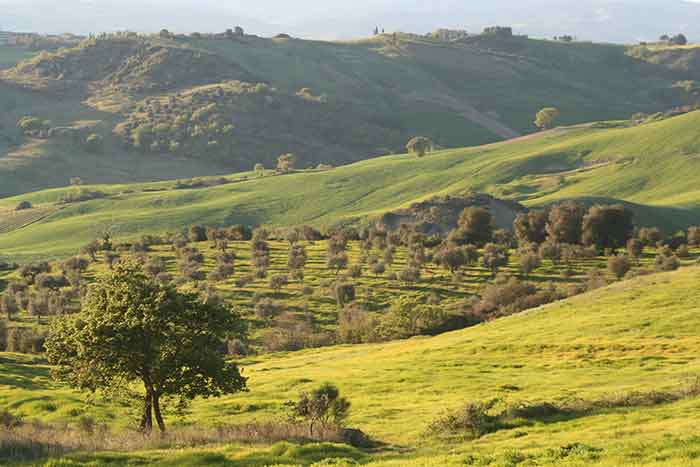 |
||||
| View on Cinigiano, and the four century-old olive trees below Podere Santa Pia |
||||
Italian villages offer the chance to experience daily living at a slower pace, a smaller scale and with more attention to the pure tastes, sights and senses; the essence of the Mediterranean life.
|
 Olivastra Seggianese |
|||
| |
|
|
||
Olive trees with centuries-old roots, Podere Santa Pia, Castiglioncello Bandini, Cinigiano
|
||||
View on Cinigiano from Podere Santa Pia
|
||||
Frazioni To the community of Cinigiano belong the frazioni Borgo Santa Rita (7 km), La Cava (7 km), Le Cosole (7 km), Monticello Amiata (10 km), Piantaverna (20 km), Poggi del Sasso (8 km), Porrona (3 km), Sasso d`Ombrone (9 km), Villa (6 km), Volpaio (7 km) and Castiglioncello Bandini (8 km).
Castiglioncello Bandini |
||||
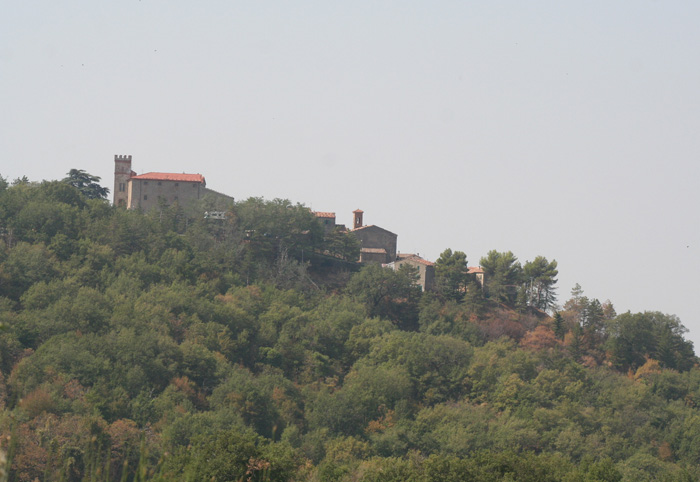 |
||||
Castiglioncello Bandini, view from the cemetery |
||||
| The fraction of Castiglioncello Bandini belongs to the municipality of Cinigiano, in the province of Grosseto, in Tuscany. Castiglioncello Bandini is situated in the eastern part of Cinigiano, at the foot of Poggio all'Olmo Nature Reserve. Originally part of the holdings of the family Aldobrandeschi, over the centuries it frequently changed ownership: first Ranieri Giamboni, then the lords of Montorgiali, then the Abbey of Monte Amiata and finally the Piccolomini Bandini of Siena. It is currently privately owned. Of the original castle, recently reconstructed, there remains the round tower with sloping base that stands out in the highest part of the town. The castle underwent several operations for the amendment and restoration, particularly in the sixteenth century, and between the nineteenth and early twentieth when it was renovated in large part neomedievale style. The internal church dedicated to San Nicola and medieval, had a replacement in the Baroque period. Tuscany | Castiglioncello Bandini
|
||||
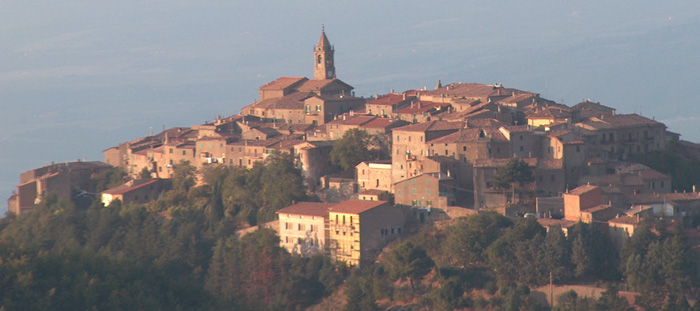 |
||||
Monticello Amiata, ensconced behind its walls, stands on the top of a hill, watching over all Maremma and surrounding valleys.
|
||||
| Along the road leading to Monte Amiata, still within the territory of Cinigiano, one finds the ancient village of Monticello Amiata. Along the road leading to Monte Amiata, in the territory of Cinigiano, one finds the ancient village of Monticello Amiata. The village is situated on a high hill, surrounded by a striking chestnut tree wood, and overlooks the valley of the Ombrone River. During the Middle Ages, the Abbey of San Salvatore and the Aldobrandeschi counts disputed at length over Monticello; at the same time, a certain local independence was being established and the inhabitants formed themselves into a municipality. After the castle burned in 1240, the people constructed a new settlement and set up their own Statutes. Thereafter, similar to most of the surrounding territory, the village of Monticello was subdued by the Republic of Siena. The walls enclosing the castle have retained their elliptical shape and are still visible, although many homes have been built over them. In addition, three protruding towers and two gateways are still preserved: the Monticelli gate and the gate of San Francesco. A Renaissance complex located in Via Grande contains a museum, in which a traditional farm home, with furnishings and equipment relative to the farming culture, has been reproduced.[1] The church of San Michele Arcangelo, patron saint of Monticello Amiata, stands in the centre of the village. The church preserves a superb painting by the Sienese artist Bartolomeo Neroni, a student of Sodoma, one of the most well known artists of 16th century Italy; the painting represents La Madonna col Bambino in trono incoronata da angeli e adorata dai santi Lorenzo e Antonio abate (Madonna and Child on a throne encircled by angels and being worshipped by Saints Lorenzo and Antonio). On the outskirts of the town rises the church of Madonna di Val di Prata, an ancient Marian sanctuary surrounded by a lovely park, in which is kept an 18th century altarpiece with La Madonna del Carmine, a work by Giuseppe Nicola Nasini, one of the greatest artists of 17th century Amiato.[1] Casa Museo is a small ethnographic museum located in an old oilmill. The exhibition reveals many aspects of daily life, economy and folklore of the 18th and 19th centuries through a series of items, tools and reconstructions of domestic environments. The oil press with its huge millstone and the tools for chestnut processing are particularly interesting. www.museidimaremma.it | Casa Museo The Museums of Maremma | Monticello Amiata - Museum House Do not miss the Festa della Castagna and the Festa dell'Olio: Monticello dedicates the second Sunday of October to the chestnut harvest and the last Sunday of November to the new olive oil. |
|
|||
Simply by not owning three medium-sized castles in Tuscany I have saved enough money in the last forty years on insurance premiums alone to buy a medium-sized castle in Tuscany. |
||||
Ludwig Mies Van Der Rohe
|
||||
| In the surroundings of Cinigiano we also recommend a visit to the amazing Castle of Porrona, a perfectly preserved hamlet on the top of a hill with a fantastic view. The Castle of Colle Massari and the Castle of Vicarello are also worth a visit. Castel Porrona belonged, between 1385 and 1894, to two large families of the Siena nobility, the Piccolomini and the Tolomei, and represents even today one of the most typical and best conserved villages one can find in Tuscany, offering a fascinating view over the surrounding valleys. The Pieve di San Donato in Porrona is a simple but impressive church in Romanesque style, with a single nave with transept and apse. Inside San Nicola in trono con angeli e donatori attributed to Giovanni di Marco said "da Ponte; and a Madonna con Bambino by Girolamo di Benvenuto from the beginning of the sixteenth century. The Chiesa della Madonna delle Grazie was built during the seventeenth century outside the walls of Porrona, and represents the typical stylistic elements of rural chapels.
|
||||
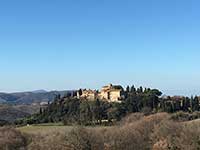 |
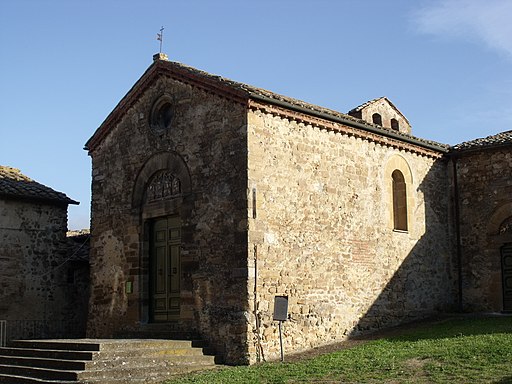 |
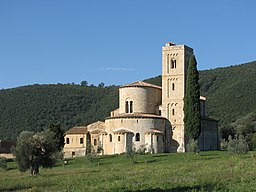 |
||
Castel Porona
|
Chiesa di San Donato, Castel Porrona, hamlet of Cinigiano
|
Sant'Antimo
|
||
| In the area of Poggi del Sasso there is the Castle of Vicarello, which in the 13th Century was part of the holdings of Siena with the name of Vico. In 1438 the castle, now fallen into ruin, was bought by a noble of Castello del Cotone (which rises a little to the North of Scansano), who, in order to reconstruct it and bring it to its initial importance, obtained the privilege from the Republic of Siena of not paying any tax. The interior of the castle, in an L-shape around a courtyard that is entered by a gateway with a round arch, cannot currently be visited, given that it is private property.
The third castle in the Commune of Cinigiano is Colle Massari, which was originally recorded by the name of Colle Sabbatini and is on the border with the Commune of Campagnatico. The first owners were the monks of the Abbey of San Galgano, and then in 1278 two thirds of it passed to the Republic of Siena. In 1355 the part that was still the property of the monks of San Galgano was ceded to Guido of Castello del Cotone. It presents itself as a fortified farm, constituted by buildings that are developed in a U-shape around a rectangular-shaped central courtyard, and in the corners of the perimetral wall there are placed round towers with a trapezoidal base. |
|
|||
|
|
||||
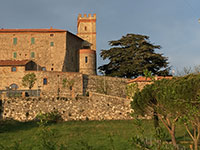 |
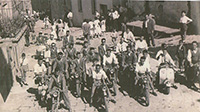 |
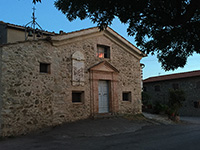 |
||
Castiglioncello Bandini, Castiglion del Torto
|
Castiglioncello Bandini | La Chiesa del Madonnino in Castiglioncello Bandini | ||
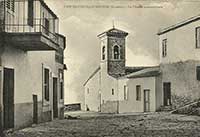 |
 |
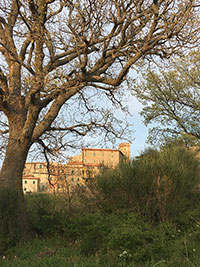 |
||
La chiesa di San Nicola, cartolina postale
|
La chiesa di San Nicola, Castiglioncello Bandini
|
Castiglioncello Bandini, castello | ||
Cinigiano borders Arcidosso, Campagnatico, Castel del Piano, Civitella Paganico, Montalcino.
|
||||
|
||||
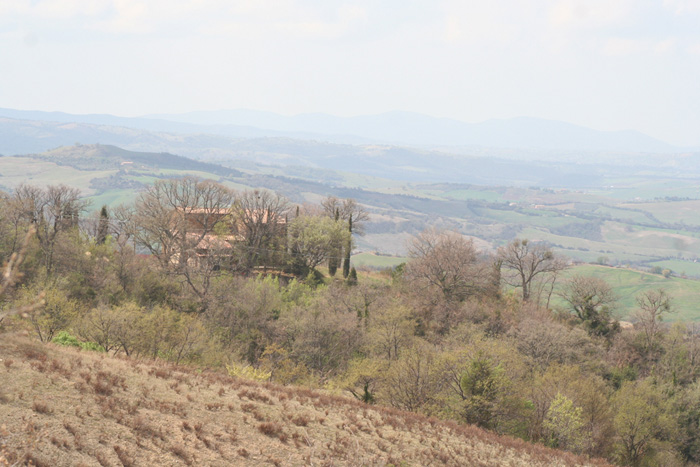 |
||||
Podere Santa Pia, between Castiglioncello Bandini and Cinigiano, overlooking the Maremma hills. These hillswere once part of the estate of the nearby Porrona Castle managed by the Abbey of Sant’Antimo in the Middle Ages. Land ownership was disputed over the centuries between the two most famous aristocratic families of Siena, the Piccolomini and Tolomei. During the 1950 land reform most of these lands were expropriated by the State and allocated to small farmers. |
||||
Monte Amiata is a unique presence in the landscape of Maremma. It is the only mountain of the southern Tuscany and the highest Italian extinct volcano. Monte Amiata is an ideal place to discover on foot. There are many lovely walks around Podere Santa Pia and Monte Amiata. A network of hiking itineraries cover both sides of the mountain. The Agenzia per Il Turismo Monte Amiata proposes 34 itineraries of varying difficulty following the old mule trails and traditional paths which make up over 200 kilometers of trekking. Walking in southern Tuscany | Itineraries exploring Castiglioncello Bandini and the Mediterranean macchia in the valleys around the village
|
||||
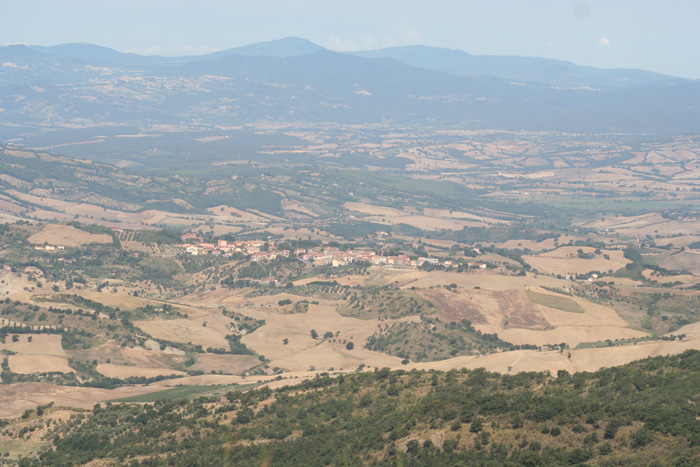 |
||||
Cinigiano
|
||||
| The Olivastra di Seggiano |
||||
The medieval hilltop village of Cinigiano, surrounded by vineyards and olive groves dating back to the 10th
century, lies at an altitude of 350 m on the slopes of Monte Amiata and Monte Labbro. |
||||
D.O.C. Montecucco |
||||
| Montecucco wine is produced in the province of Grosseto, in an area which is particularly renowned for high quality wines. This zone is surrounded by names of great prestige such as Brunello di Montalcino, Morellino di Scansano, S. Antimo and Monteregio di Massa Marittima. All Brunello di Montalcino wine is made exclusively from Sangiovese grapes grown on the slopes around Montalcino, a classic Tuscan hilltop village north of Cinigiano. The word Brunello translates roughly as 'little dark one', so named for the brown hue of its skin, and is the local vernacular name for Sangiovese Grosso, the form of Sangiovese which grows in the area. Morellino di Scansano is one of Italy's hidden gems: it is one of eight DOCGs situated in the charming region of Tuscany. It was only made a DOC in 1978 and awarded its higher classification in 2007, but its viticultural origins go back as far as Etruscan times. Morellino di Scansano wine is produced in the hilly area around the medieval village of Scansano. The seven comununities which produce the Montecucco DOC wine are, besides Cinigiano: Civitella Paganico, Campagnatico, Castel del Piano, Arcidosso, Seggiano and Roccalbegna. The Montecucco wine trail (La Strada del Vino Montecucco) consists of a main roadway with five turn-offs. It can also be found on the official site of Strada del Vino Montecucco - Montecucco Wine Trail. The Montecucco Wine Trail curls along the hills of the Upper Maremma and can be divided in five major itineraries. The first itinerary is centred in the area of Campagnatico; the second includes Monte Antico, Civitella and Pari; the third runs through the countryside around Cinigiano; the fourth includes the lower side of Mount Amiata and the fifth leads to the area of Montenero and Seggiano. The soil of the Maremma consists predominantly of fragmented sandstone, to which characteristically is added the lava composites from the age when Monte Amiata still was an active volcano. The lava presence gives the vines a mineral character and tastiness typical for the area. Each of the wine producers in the region has its own different character. ColleMassari is one of the very modern wine cellars built by the famous architect Edoardo Milesi. It is owned by the two sisters Maria Iris and Claudia Tipa who also own the Grattamacco vineyards in Bolgheri as well as Sotto in Montalcino. Cantina Pieve Vecchia is also an ultra-modern installation designed by Cini Boeri. Cantina Pieve Vecchia is based in Campagnatico, a small medieval village in the heart of Maremma, the farm owes its name to the archeological site of Pieve Vecchia upon which it is situated, which has Etruscan origins. The Salustri farm is situated between the hills of Poggi del Sasso in the heart of the Montecucco D.O.C. district. The central village is surrounded by 150 hectares of woodland, vineyards and olive groves and dates back to 13th century, a time when the cultivation of vines was already one of the most developed rural activities. Near Podere Santa Pia, Daniele Rosellini and Nadia Riguccini created the Campinuovi farm. Campinuovi, with a total area of 23 hectares, cultivates 7 hectares of grapevines consisting of 85% Sangiovese with the remaining other red grapes (Colorino, Pugnitello, Merlot, Cabernet Sauvignon) and white grapes (Ansonica). [ www.campinuovi.com] Other producers of Montecucco include Tenuta di Montecucco, Salustri, Castello di Potentino, Ciacci Piccolomini d'Aragona, Santa Marta, Fattoria la Lecciaia di Pacini Mauro e C., Azienda Agricola Perazzeta, Podere il Casino, Pertimali (Livio Sassetti), Montesalario, Assolati, Azienda Agricola, Azienda Agricola Rabazzi Vanda, Fattoria La Lecciaia (Pacini), Le Calle di Catocci, Leonardo Salustri, Lo Scoglio, Lo Scolio, Lorenzo e Luciano Sassetti, Orciaverde and Parmoleto. Parmoleto produces a good range of well-made wines including a Bianco made with Malvasia Bianca (40%), Trebbiano (30%) and Chardonnay (30%); Montecucco Sangiovese DOC (85%, plus 10% Montepulciano d’Abruzzo and 5% Syrah), matured in second and third year barrels; Sangiovese riserva (2004) matured for two whole years in wood, to the Sangiovese/Cabernet blend, Sormonno 2005. [www.parmoleto.it] Wines in Tuscany | D.O.C.G. Montecucco La Strada del Vino Montecucco (The wine road of the Montecucco) Also the wine road of the Montecucco is part of the four Maremman wine roads. Starting from north with Bagno di Petriolo, passing Civitella Marittima until the center of the area with Cinignano. From there it goes towards west, passing the Mountain Montecucco after which is called the wine road, until Campagnatico. The easter part is Monticello, Castel del Piano (Torre dell'Orologio) and Seggiano. |
||||
Chestnuts from Monte Amiata |
||||
Among its famous local products, the Montecucco Wine Route also includes Igp chestnuts from Monte Amiata. The largest concentration of chestnut groves can be found in the municipalities of Castel del Piano, Arcidosso and Seggiano, but the areas covers eight municipalities in the Grossetto province and three in the province of Siena.
|
||||
Cycling in Tuscany | (It)
Dall’ Amiata alla pianura e ritorno
|
||||
 |
||||
View of Sasso d'Ombrone, Grosseto [2] |
||||
Restaurants in Cinigiano, and the frazionin Santa Rita, La Cava, Le Cosole, Monticello Amiata, Piantaverna, Poggi del Sasso, Porrona, Sasso d`Ombrone , Villa, Volpaio and Castiglioncello Bandini. Our choice: Il Rintocco, Piazza Marconi, Cinigiano for teeir excelend food and Montecucco wines, and the circolo La Rosa dei Venti in Castiglioncello Bandini for the outstanding pizze on Saturday evening. |
||||
|
||||
|
||||
|
||||
|
||||
|
||||
|
||||
|
||||
|
||||
|
||||
|
||||
| [1] Source: Provincia di Grosseto | Monticello Amiata (Cinigiano) | www.parcodeglietruschi.it [2] Foto Alienautic, licenziato in base ai termini della licenza Creative Commons Attribution-Share Alike 3.0 Unported. |
||||
Comune Cinigiano Cicloturismo in Maremma | 35 itineraries in the Tuscan Maremma (it) Maremma Riserva di Natura - Provincia di Grosseto | Riserva Naturale Provinciale POGGIO ALL’OLMO (it) |
||||

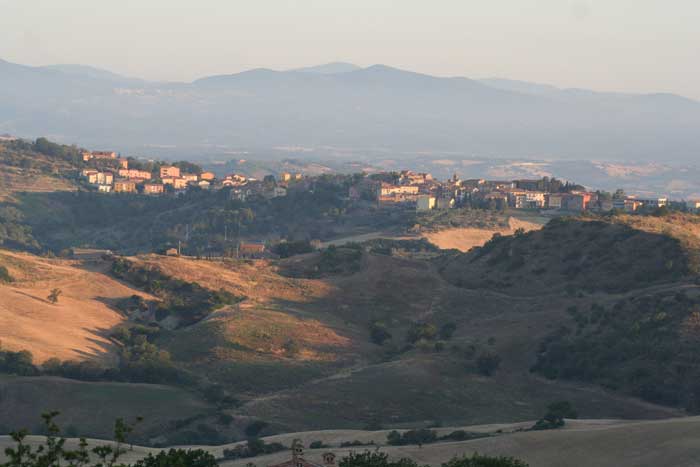
 Forecasts and weather
Forecasts and weather
